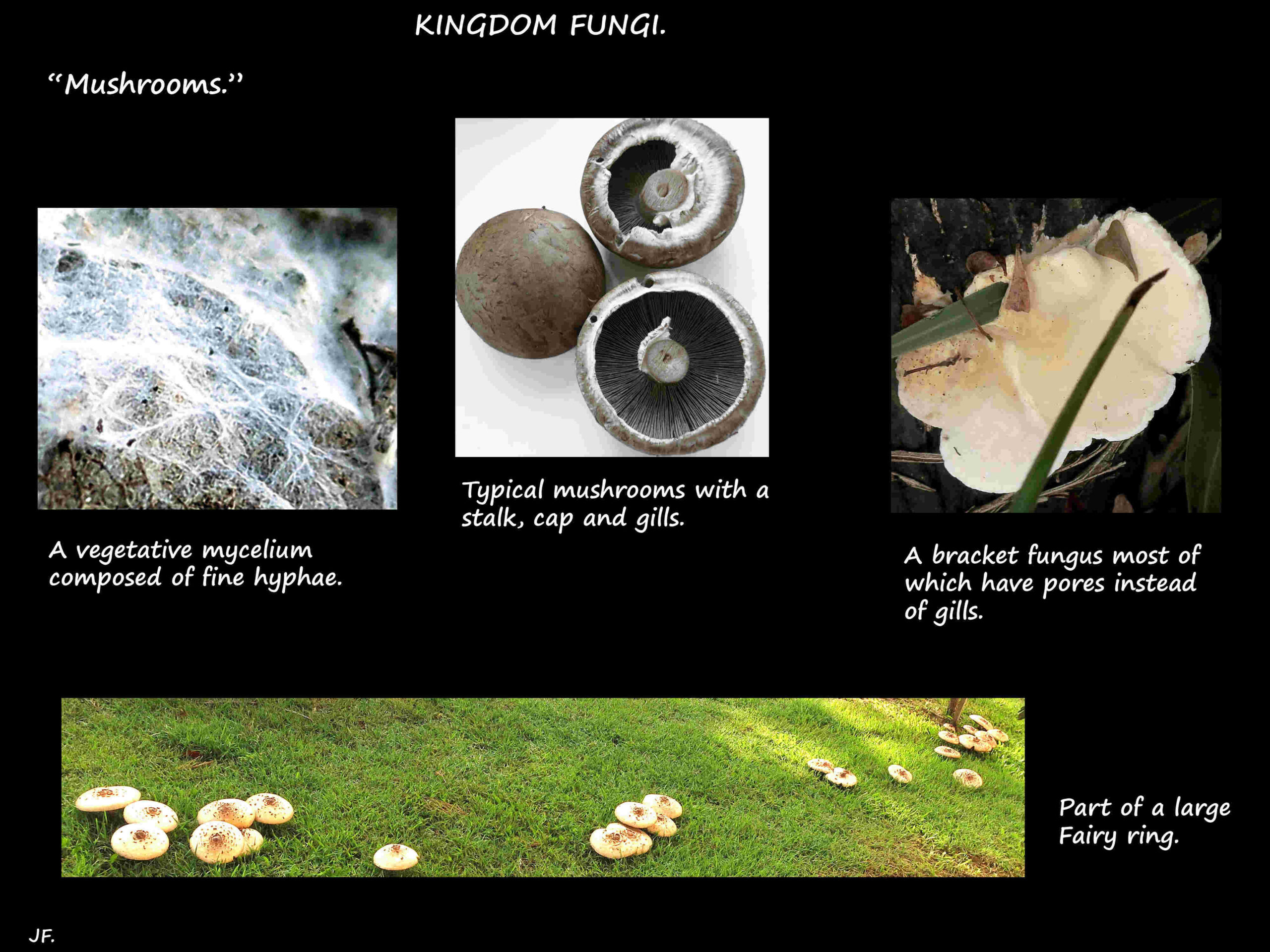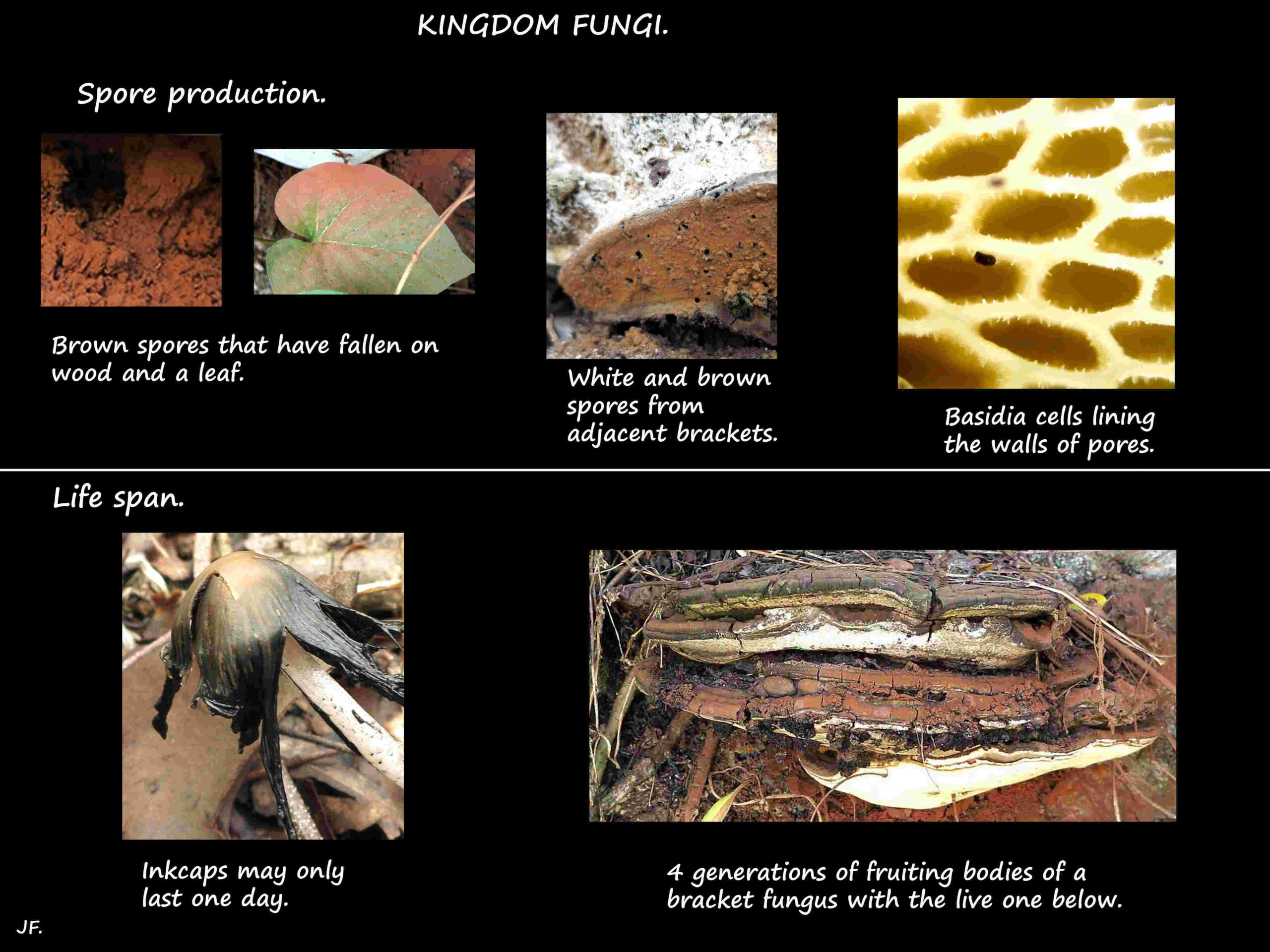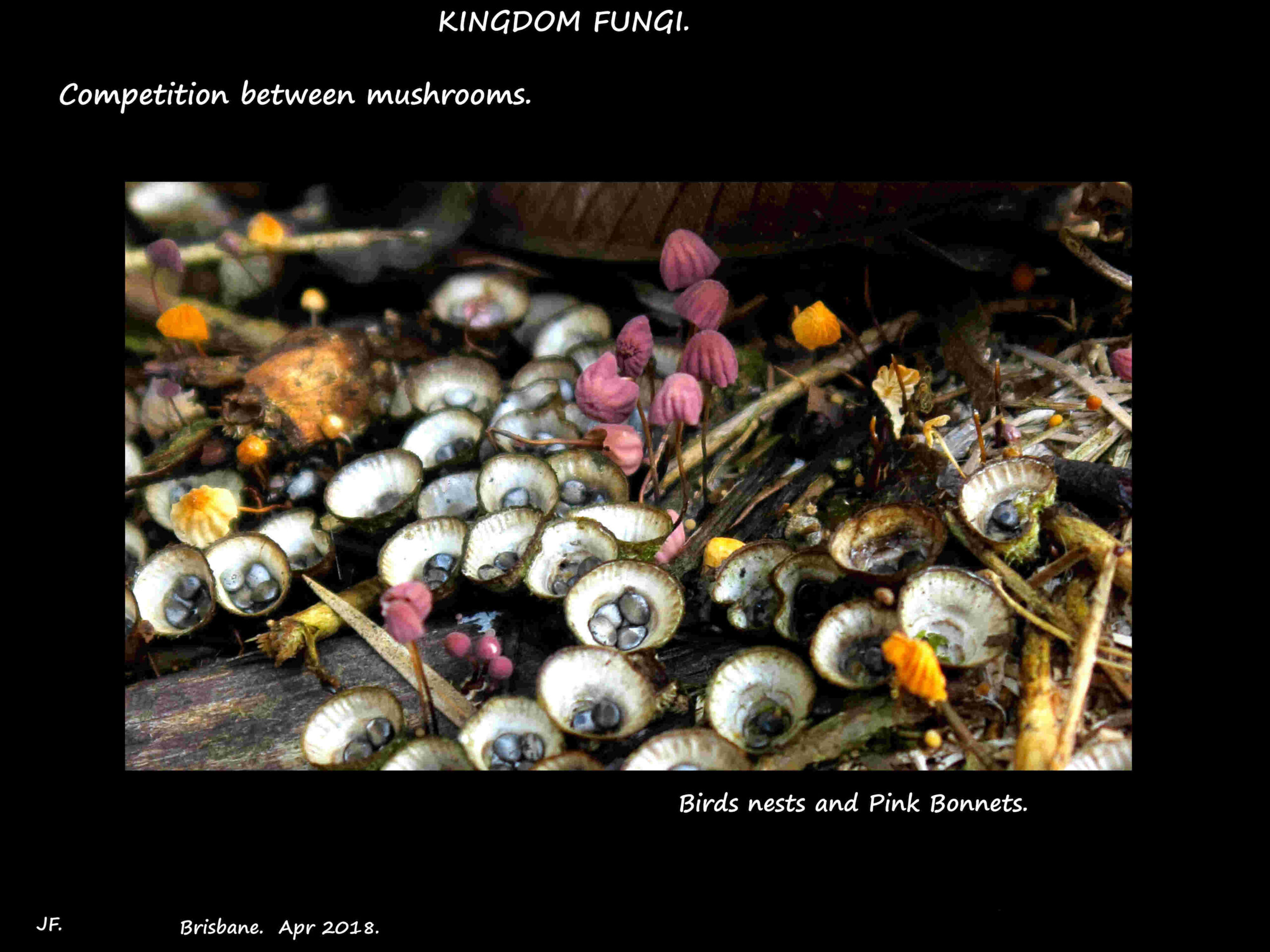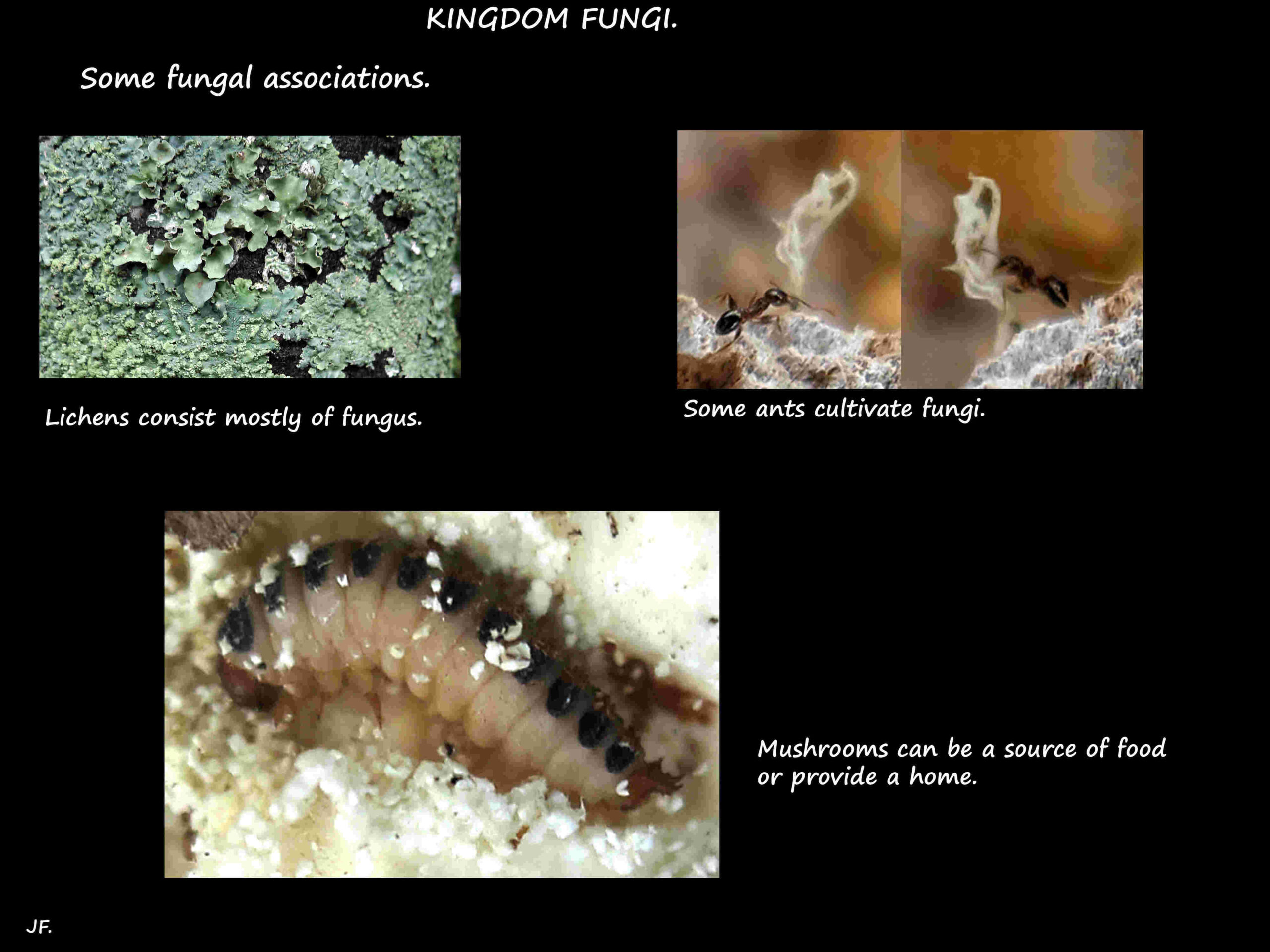What are Mushrooms?
The word “mushroom” is a loose term and covers any fungus with a visible spore-producing fruiting body.
Typically this has a fleshy stem, cap and gills but may also include the leathery brackets and other forms.
Other mushrooms include the puffballs and stinkhorns.
It includes some Ascomycetes but mostly Basidiomycetes.
Approximately 14,000 species of mushrooms have been described worldwide.
Basic structure of fungi.
Fungi are made up of very fine filamentous cells or hyphae which, when massed, form a mycelium.
1. The underground vegetative mycelium is 90% of the bulk of the fungus and may last for years.
2. The visible reproductive mycelium – the mushroom – produces the spores.
This may be transient as in the Inkcaps which only last a day or last for years like some leathery brackets.
Fungi have no chlorophyll so cannot manufacture their own food.
Instead they secrete enzymes which break down organic matter so it can be absorbed.
Unless interrupted the mycelium spreads outwards in all directions in search or more organic matter.
This pattern of growth is responsible for the Fairy Rings commonly seen on lawns.
It is also seen in lichens which are largely composed of fungi.
Spore production in the Basidiomycetes.
Basidiomycetes produce spores on club-shaped projections which grow from basidia cells.
The basidia cells line the hymenium which is on, or in, the fruiting body.
Commonly seen mushrooms have the hymenium on gills under the cap.
The bracket fungi have tubes lined with basidia and puff balls have internal hymenia.
Spore release may be either active (e.g. puffballs) or passive (wind, insects etc.).
Spore release lasts a few days in gilled mushrooms but up to years in some bracket fungi.
Spores are minute but produced in massive numbers.
Spore colours include white, black, brown, pink or purplish.
Reproduction can be by mitosis (asexual) or meiosis (sexual).
Fungal associations.
Many fungi have important symbiotic relationships with organisms from other Kingdoms.
Over 90% of all plant species have a relationship with a fungus.
The fungus obtains carbohydrates the plant has made by photosynthesis and the fungus greatly
improves the absorption of water and minerals by the plant.
Lichens are a symbiotic relationship between fungi and algae or cyanobacteria.
Some ants cultivate fungi.
Competition.
Organisms are always competing for food and space.
Fungi use various techniques to kill or inhibit competitors.
These include the production of antibiotics or secondary metabolites.
***************************************************************
Phylum Basidiomycota (club fungi).
The Basidiomycetes are characterised by having spores produced on microscopic club-shaped cells called basidia, each with 4 or 2 spores.
The basidia are on the gills or tubes or on the surface depending on the form of the fruiting body.
It is a large phylum containing most of the commonly seen fungi.
Phylum Basidiomycota > Subphylum Agaricomycotina has three classes.
Class Tremellomycetes includes the unicellular yeasts and some gelatinous fungi.
Class Dacrymycetes including Order Dacrymycetales with cup to cone-shaped fruiting bodies.
Class Agaricomycetes with 17 orders.
Agaricomycete orders.
Order Agaricales. Many are typical cap and stalk mushroom with gills; some puffballs and earthstars.
Order Boletales. The boletes and some puffballs.
Order Geastrales. Includes some earthstars.
Order Phallales. Includes some stinkhorns.
Order Auriculariales. Gelatinous fruiting body.
Order Cantharellales. Includes Cantharellus and Craterellus.
Order Polyporales. Pores instead of gills e.g. Polyporus, Fomitopsis.
Order Russulales. Includes Russula, Aleurodiscus and Stereum.
The other orders are the Atheliales, Corticales, Gomphales, Gloeophyllales, Hysterangiales, Hymenochaetales,
Sebacinales, Thelephorales and Trechisporales.
Grouping of mushrooms.
Grouping is an arbitrary process of dividing a large number of things into groups.
It is not classifying them which is a scientific process.
In identifying fungi the first thing to consider is their gross appearance.
Following this are microscopy and chemical tests then genetic analysis.
There are obviously many macroscopic features by which fungi can be grouped the commonest being the type of fruit body
they form (crust, bracket etc.) and the appearance of the spore bearing layer or hymenium (gills, pores etc.)
1. Grouping by shape.
Stipitate fungi are the typical “mushrooms” mostly with a round cap and central stalk.
Bracket fungi form fan-shaped, tough fruit bodies usually with no stalk.
Crust or corticioid fungi are flat like a paint splash but may form small caps.
Then a variety of shapes — club, coral, stinkhorns, puffballs etc.
2. Grouping by the spore forming layer or hymenium.
Gilled fruit bodies have the hymenium on vertical plates under the cap.
Poroid fruit bodies have vertical tubes opening by pores – the Polypores.
Other hymenia including teeth (hydnoid), smooth, wrinkled (merulioid), spines, internal, or on the external surface.
Whichever way fruit bodies are grouped there is some overlap between their shape and the type of hymenium.
This results in various species of the same genus ending up in different groups depending on peoples definitions.
Most ‘mushrooms’ have gills but some have false gills or pores.
Most brackets have regular pores but some have gills, teeth spines etc. Crusts may be smooth, have pores, teeth etc.
My grouping of the mushrooms.
I initially grouped them by shape but have changed to the type of hymenium (spore bearing layer).
In the following pages the mushrooms are placed in the following groups.
Mushrooms with true gills e.g. Agaricaceae, Amanitaceae, Marasmiaceae, Pleurotaceae and some Polyporaceae.
Mushrooms with false gills e.g. Cantharellaceae with Cantharellus & Craterellus.
Mushrooms with pores e.g. Ganoderma, Piptoporus, Pycnoporus and Trametes.
Mushrooms with surface spores. This includes mushrooms with very varied appearances such as Club & coral fungi,
Crusts, Jelly fungi, Stinkhorns and Tooth or spine fungi.
Mushrooms with internal spores includes Puffballs, Earthstars, Birds nest fungi and Cup fungi.
Most, or all sections also have mushrooms I have not identified.
J.F.





